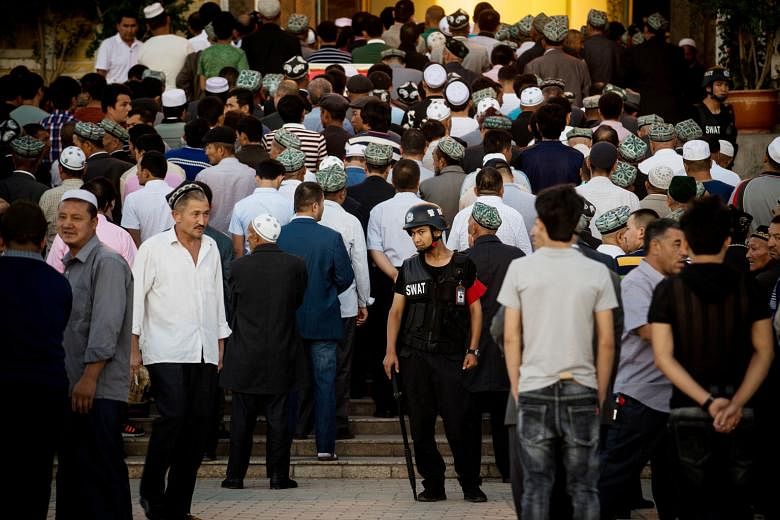BEIJING • On state television, the vocational education centre in China's far west looked like a modern school where happy students learnt to speak Mandarin, brushed up their job skills and pursued hobbies such as sports and folk dance.
But earlier this year, one of the local government departments in charge of such facilities in Xinjiang's Hotan prefecture made several purchases that had little to do with education: 2,768 police batons, 550 electric cattle prods, 1,367 pairs of handcuffs and 2,792 cans of pepper spray.
The shopping list was among over 1,000 procurement requests made by local governments in the Xinjiang region since early last year related to the construction and management of a sprawling system of "vocational education and training centres".
The facilities have come under international scrutiny, with rights activists describing them as political re-education camps holding as many as one million ethnic Uighurs and other Muslim minorities.
Beijing previously denied their existence but a global outcry, including from the United Nations and the United States, sparked a public relations counter-offensive. Government propaganda insisted that the centres were aimed at countering the spread of separatism, terrorism and religious extremism through "free" education and job training.
However, an examination by the Agence France-Presse of more than 1,500 publicly available government documents - ranging from tenders and budgets to official work reports - shows the centres are run more like jails than schools.
Thousands of guards equipped with tear gas, Tasers, stun guns and spiked clubs keep tight control over "students" in facilities ringed with razor wire and infrared cameras, according to the documents.
The centres should "teach like a school, be managed like the military and be defended like a prison", said one document, quoting Xinjiang's party secretary Chen Quanguo.
To build better Chinese citizens, another document argued, the centres must first "break their lineage, break their roots, break their connections and break their origins".
The centre featured on state broadcaster CCTV last week is one of at least 181 such facilities in Xinjiang, according to data collected by AFP. Participation is voluntary, according to CCTV, which showed contented "students" wearing matching uniforms, studying Mandarin and learning trades like knitting, weaving and baking.
The centres first appeared in 2014, the year authorities launched a new "strike hard" campaign against "terrorism" after violence in Xinjiang.
But the build-up began in earnest early last year, with local governments in predominantly Uighur southern Xinjiang ordered to speed up the construction of "concentrated educational transformation centres for focus groups" - a euphemism for the religious, the poor, the uneducated, passport holders and virtually all men of military age.
Shortly after, Xinjiang's regional government issued regulations on managing "religious extremism". "Detain those who should be detained to the greatest extent possible," cadres were told.
Detentions surged, catching local governments unprepared. Last year, spending by justice bureaus throughout Xinjiang exploded, driven largely by outlays for building and running vocational centres.
Yesterday, Chinese foreign ministry spokesman Hua Chunying questioned the report's findings but offered no specific denial. "I want to express my strong doubts on whether the situation you described is true," she told an AFP reporter at a regular press conference.
At the end of last year, "higher authorities" issued directions to standardise the facilities' operations.
New "vocational education and training service management bureaus" were set up, headed by officials experienced in running prisons and detention centres, according to local government websites.
Students would be tested on their knowledge of propaganda on a weekly, monthly and "seasonal" basis, one bureau wrote in a memo.
While China has rejected estimates that upwards of one million people are held in the centres, tender documents hint at huge numbers. In a one-month period in early 2018, Hotan county's vocational education bureau, which oversees at least one centre, ordered 194,000 Chinese language practice books.
And 11,310 pairs of shoes.
AGENCE FRANCE-PRESSE

